The lighting design for batting and bowling sessions must address particular requirements, and even the cricket court itself has recommended lux levels to maintain safety and security for players.
This guide will cover all the essential criteria and indicators for choosing the best indoor cricket court lighting. You will first learn about the various light sources used in an indoor cricket facility, followed by a discussion on the importance of adequate illuminance, as well as an exploration of cricket lighting standards and design principles.
Table of Contents
ToggleLighting for Indoor Cricket Practice Nets
When setting up an indoor cricket practice net, the type of lighting used is crucial to ensure safety, visibility, and an effective training environment. The lighting should be tailored to meet the specific needs of the practice space, providing sufficient brightness and coverage without causing glare or discomfort. Here, we explore the two primary types of lights commonly used in indoor cricket facilities.
High Bay Lights for Indoor Cricket Practice Nets
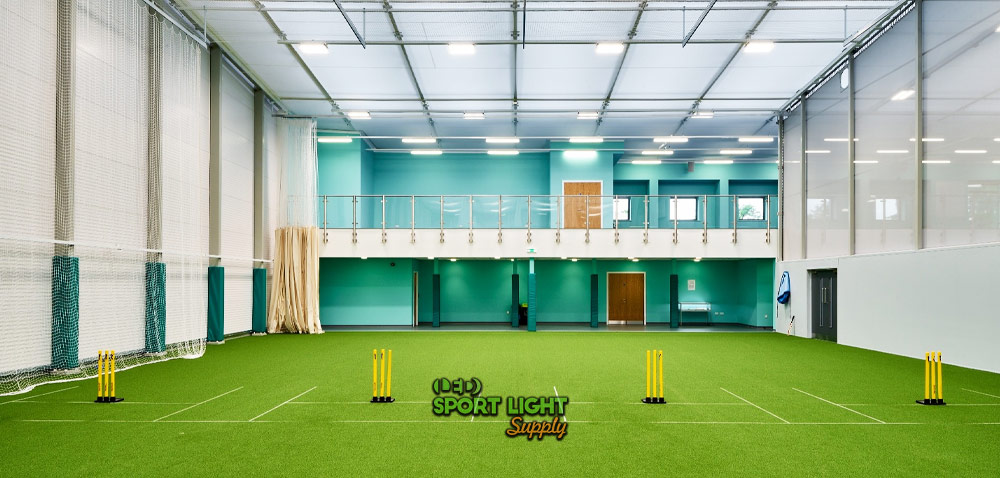
High bay lights are powerful lighting fixtures designed for high ceilings, making them ideal for indoor cricket practice nets. These lights are highly effective at illuminating large areas from a height, ensuring consistent and even lighting across the entire playing surface.
In particular, LED high bay lights are favored for their versatility, energy efficiency, and long lifespan. These lights come in various shapes, with the circular (UFO) and rectangular (linear) models being the most popular. They can be installed on frames, gaskets, or suspended from the ceiling, providing flexible installation options. Additionally, LED high bay lights are cost-effective and easy to control, making them a preferred choice for many indoor cricket facilities.
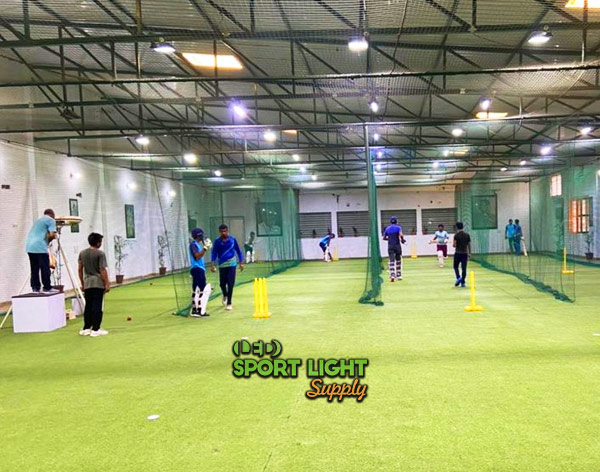
High Power Flood Lights for Indoor Cricket Practice Nets
High power flood lights are another common lighting solution for indoor cricket practice nets. These fixtures are designed to provide broad coverage with a large beam angle, making them ideal for illuminating wider areas. LED flood lights are available in various wattages, such as 400W, 1000W, and 2000W models, offering powerful illumination without generating excessive heat.
One of the advantages of high power flood lights is their portability and ease of installation. They can be mounted on tripods to create a DIY portable lighting solution, or fixed in place with additional accessories like glare shields. These lights are particularly useful for providing angled illumination, making them a versatile option for different lighting setups within the practice net.
Choosing Between High Bay Lights and Flood Lights
The choice between high bay lights and flood lights depends on the specific requirements of the indoor cricket practice net. High bay lights are typically used for standard downward illumination, providing consistent lighting from above. In contrast, flood lights offer the flexibility of angled lighting, which can be beneficial for covering wider areas or specific sections of the net. Both types of lights have their unique advantages, and the best choice will depend on the layout and lighting needs of the indoor cricket facility.
Importance of Indoor Cricket Ground Lights
Effective lighting is essential for indoor cricket grounds to ensure optimal training and playing conditions. Proper lighting design not only enhances visibility but also ensures safety and convenience. Adhering to recommended lighting standards is crucial for maintaining the appropriate lux levels required for various activities. Here, we discuss the key reasons why understanding and implementing proper indoor lighting is vital for cricket practice and games.
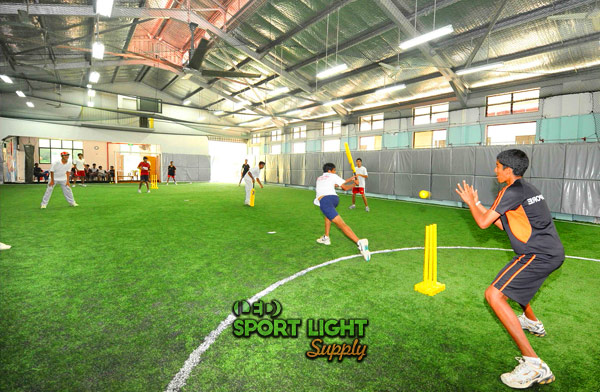
Nonstop Cricket Practice
One of the primary advantages of installing high-quality lighting in an indoor cricket ground is the ability to conduct uninterrupted practice sessions. LED lights are particularly beneficial in this regard due to their reliability and stability. These lights can operate continuously, making them ideal for facilities that require 24/7 lighting, such as indoor stadiums and cricket clubs.
LED lighting allows for flexible use of the cricket practice net. Coaches and players can turn the lights on and off as needed without waiting for the lights to cool down or reach their maximum brightness. This capability ensures that training sessions can be held at any time, maximizing the use of the facility and accommodating various practice needs.
Improved Player Vision
For example, a top-level bowler can deliver a cricket ball at speeds up to 160 km/h, as demonstrated by players like Shoaib Akhtar. To effectively train under such conditions, players need clear visibility of the ball coming towards them.
Using a combination of flood lights and high bay lights can significantly improve luminance and cover all angles of the practice net. This setup ensures that players can see the ball clearly, which is essential for developing skills and reacting effectively during training.
Enhanced Security
Well-lit areas help deter unauthorized access and potential security breaches. For coaches, facility managers, and school representatives, ensuring that the venue is well-lit is vital for preventing trespassing and ensuring the safety of students and players.
In addition to general lighting, the design should also include illumination for emergency exits and safe areas for evacuation. Adequate lighting helps in guiding people safely out of the building in case of an emergency. Moreover, it reduces the risk of accidents involving staff or players who may be near the practice net.
Indoor Cricket Practice Net Lighting Standards
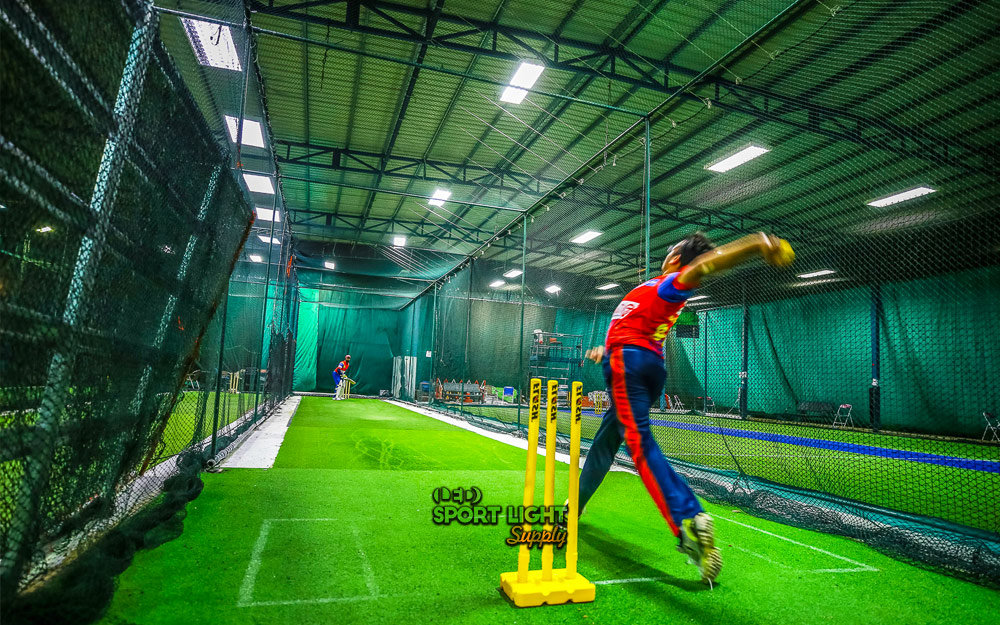
To ensure optimal conditions for indoor cricket practice and games, adhering to specific lighting standards is essential. These standards are designed to provide the necessary illuminance and uniformity required for both training and competitive play, preventing injuries and enhancing performance. Below, we outline the key requirements for indoor cricket lighting based on professional standards.
Lux and Footcandle Levels

Lighting standards for indoor cricket practice nets are determined by the intensity of illumination, which is measured in lux or footcandles. The European Standard EN 12193 provides guidelines for these measurements. Generally, there are three main levels of lighting based on the competitive level of play:
| Level | Description | Illumination Required | Approximate Footcandles |
|---|---|---|---|
| Level I | For low-level club matches and activities | 750 lux | 69.70 |
| Level II | For regional competitions and standard clubs | 1000 lux | 92.93 |
| Level III | For national and international competitions | 1500 lux | 139.40 |
These levels ensure that the lighting meets the needs of varying levels of cricket play, from amateur to professional.
Lighting Uniformity
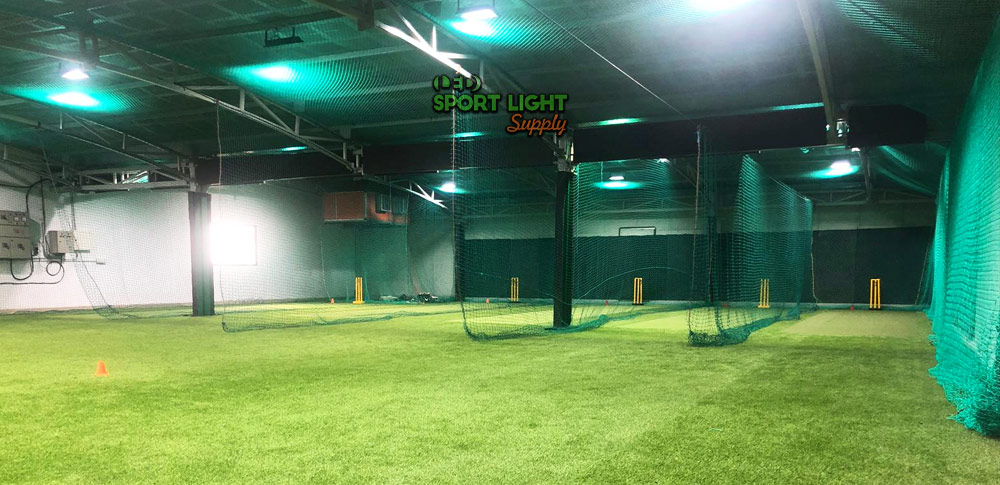
Lighting uniformity refers to the even distribution of light across the practice area, which is crucial for maintaining consistent visibility. This includes both vertical and horizontal uniformity, ensuring that all areas of the cricket practice net are adequately lit.
To achieve optimal uniformity, a lighting grid should be used to measure the light levels at various points within the facility. The uniformity ratio, which is the ratio of the minimum to average lux values, should be at least 0.8. This ensures that there are no significant variations in lighting intensity that could affect the players’ ability to see the ball clearly.
Ceiling Height of the Practice Net
The ceiling height of the indoor cricket practice net plays a significant role in lighting effectiveness. A minimum ceiling height of 4 to 5 meters is recommended to ensure good light distribution and minimize glare. This height helps maintain high light uniformity and provides sufficient space for players to practice effectively without obstruction.
The ceiling height also influences the overall design of the practice area, including the spacing and length of the hall. Adequate height is essential for allowing bowlers to perform their run-ups and for installing the necessary lighting fixtures.
Color Temperature
Color temperature, measured in Kelvin (K), describes the hue of the light emitted by the fixtures. For indoor cricket practice nets, it is important to select lights with a color temperature above 5000K to ensure a clear and natural lighting environment. However, avoid choosing fixtures with a color temperature too high, such as 6500K, as this can result in overly bluish light.
A color temperature in the range of 5000K to 6000K is typically recommended, providing a balance between visibility and comfort.
Background Contrast
Background contrast affects how well the lighting performs in relation to the surrounding environment. Light-colored walls and ceilings improve reflectance, which helps in creating more contrast and enhancing visibility.
For indoor cricket facilities, the reflectance value should be between 0.3 and 0.6 for walls and between 0.6 and 0.8 for ceilings. This ensures that the reflected light does not cause glare or visual discomfort, contributing to a better overall lighting experience.
Indoor Cricket Ground and Practice Net Lighting Design and Layout
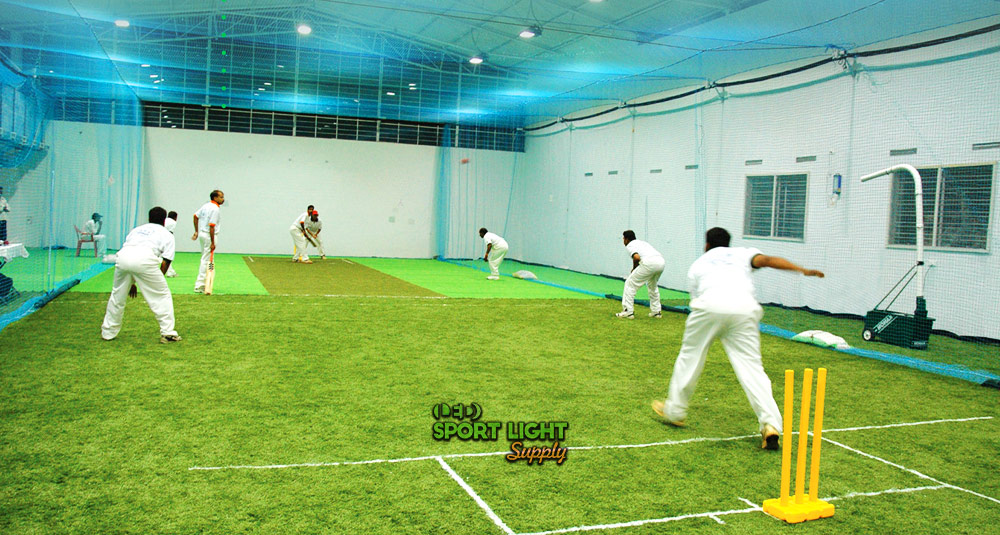
Designing the lighting for an indoor cricket ground and practice net involves careful planning to ensure safety, comfort, and optimal performance. The key elements to consider include installation height, spacing between fixtures, wattage requirements, and ceiling types. Here’s a detailed guide to achieving an effective lighting layout for indoor cricket facilities.
Installation Height
Lights should be mounted high enough to avoid any risk of players bumping into them, while also ensuring adequate coverage and minimizing glare. The ideal height will depend on the type and quality of the high bay lights or flood lights used, as well as whether they are fixed or hinged.
To achieve the recommended lux level for indoor cricket, it is essential to calculate the correct installation height. This calculation should be done with the assistance of a lighting expert or using appropriate measuring equipment to ensure that the lighting design meets the required standards.
Distance Between High Bay Lights or Flood Lights
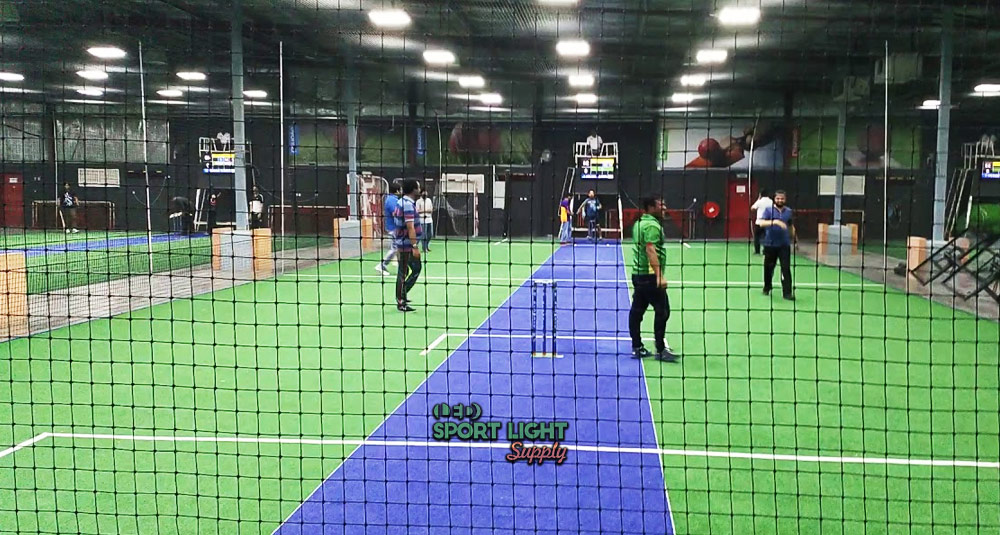
The spacing between lighting fixtures plays a significant role in achieving even illumination and avoiding dark spots. Typically, the distance between high bay lights or flood lights should be between 5 to 10 feet (1.5 to 3 meters), depending on the beam angle and ceiling height.
For cricket practice nets with multiple lanes, it is important to design the lighting layout to accommodate several players and reduce glare. Ensuring a minimum distance from the sidewalls can also help maintain a consistent light level across the court. A well-planned layout will consider the court format and custom solutions to provide optimal lighting conditions.
Wattage of Indoor Cricket Net Lighting
Choosing the right wattage for lighting fixtures depends on the required lux levels. In general, you may need between 400 to 2000 watts of LED lighting, depending on the brightness needed.
Instead of focusing solely on wattage, it is more effective to determine the required lumen output. Lumens measure the total amount of visible light emitted by a fixture, which directly impacts the lux level. Understanding the lumen-to-watt ratio of your chosen LED fixtures will help you achieve the desired illuminance for your indoor cricket practice net.
Vaulted Ceiling or Flat Ceiling
The type of ceiling in your indoor cricket facility will influence the lighting design and installation.
For flat ceilings, the lighting design is straightforward. Fixtures can be ceiling-mounted, installed on frames, or hung directly from the ceiling. This setup generally involves fewer complications and allows for easier adjustments.
In contrast, vaulted ceilings require a more nuanced approach. Smaller beam angle fixtures should be placed at the lower part of the vaulted ceiling, while larger beam angle fittings should be installed at the higher part. This arrangement ensures that light is evenly distributed across the space, with lower power output at the edges and higher output at the center. Regular checks with a lux meter are essential to make any necessary adjustments and ensure optimal lighting conditions.
How to Select the Best Indoor Cricket Court Lights
Choosing the right lights for an indoor cricket court is essential for ensuring optimal playing conditions, safety, and energy efficiency. Here are seven essential factors to consider when selecting lighting for your indoor cricket practice net:
Luminous Efficacy
Luminous efficacy measures how well a light source converts electricity into visible light, expressed in lumens per watt. For indoor cricket practice nets, look for lights with at least 130 lumens per watt. This level of efficacy provides a good balance between brightness and energy consumption, ensuring high-quality illumination while keeping costs manageable. A higher luminous efficacy means you can use fewer lights to achieve the required lux levels, contributing to overall cost savings and flexibility in light placement.
Life Span
The life span of lighting fixtures is an important consideration, especially if you want to make a long-term investment. Traditional light sources often have shorter life spans and can be prone to overheating. In contrast, LED lights typically last over 150,000 hours, offering superior longevity and reduced maintenance needs. When selecting LED lights, ensure they come with quality certifications and warranties to guarantee their durability and performance.
Beam Angle
The beam angle of a light fixture determines the spread of light across the practice net. For indoor cricket courts, a beam angle of 60 to 90 degrees is recommended. This range allows for flexibility in adjusting light distribution and achieving the desired coverage. LED flood lights are particularly versatile in this regard, as they can be easily repositioned and adapted to different lighting needs, whether for direct or indirect lighting.
Glare Control
Glare can be problematic for both players and spectators. To minimize glare, choose lights with glare-reducing features such as reflectors, lenses, or anti-glare louvers. Proper glare control ensures that players can focus on the game without visual discomfort, and spectators can enjoy a clear view of the match. Aligning light fixtures in rows parallel to the pitch axis can also help reduce glare and improve overall lighting quality.
Independent Control
For versatility and energy efficiency, consider lighting systems with independent control capabilities. Systems like DMX or DALI allow you to manage different sections of the practice net separately. This means you can light up specific areas as needed, reducing energy consumption and operational costs. Both DMX and DALI systems require a control module or controller, so make sure you have the necessary equipment to integrate and manage these systems effectively.
Direct or Indirect Lighting
Decide whether you want direct or indirect lighting for your cricket practice net. Direct lighting involves fixtures that point downward, illuminating the net directly. This type of lighting can be more prone to glare but is often simpler and more cost-effective. Indirect lighting, on the other hand, involves fixtures that point upward, using reflected light to illuminate the net. While indirect lighting generally provides better uniformity, it may consume more energy and require additional fixtures.
Emergency Lighting
Emergency lighting is crucial for safety and compliance with regulations. Ensure that your indoor cricket facility is equipped with emergency lights to cover both practice and match areas. These lights should guide spectators and players safely out of the facility in case of an emergency. Compliance with the International Building Code and other safety standards is essential, and having emergency lights available will also be useful during maintenance and repairs.
LED Replacement of Metal Halide, Mercury, and Halogen Cricket Ground Lights
When it comes to upgrading or retrofitting cricket ground lighting, LED lights are increasingly the preferred choice over traditional metal halide, mercury, and halogen fixtures. LEDs offer several significant advantages, making them a superior option for modern cricket facilities.
Better Energy Efficiency
One of the most notable benefits of LED lights is their energy efficiency. LEDs use a fraction of the wattage required by metal halide, mercury, or halogen lights to achieve the same level of brightness. This reduction in energy consumption directly translates to lower electricity bills. Additionally, LEDs generate less heat compared to their traditional counterparts. They are designed with heat sinks that dissipate heat efficiently, reducing the risk of overheating and extending the lifespan of the fixture. Unlike traditional lights, LEDs do not pose disposal issues since they do not contain hazardous materials.
Longer Life Span
LED lights outlast metal halide, mercury, and halogen bulbs by a considerable margin. Traditional lighting technologies such as metal halide lamps typically have a lifespan of around 10,000 to 20,000 hours, while halogen bulbs last between 2,000 and 6,000 hours. In contrast, LED lights can last over 100,000 hours, significantly reducing the frequency of replacements and associated maintenance costs. This extended lifespan makes LEDs a more reliable and cost-effective solution over time.
More Flexible Lighting Control
Modern LED lights offer advanced control features that were not available with older lighting technologies. For instance, LED systems can be controlled wirelessly via smartphones, DMX controllers, or Bluetooth connections. This capability allows for precise adjustment of brightness and illuminance levels, catering to various training and game requirements. The ability to control lighting remotely and adjust settings in real-time adds a layer of convenience and flexibility that traditional lighting systems cannot match.
Cooler Operation
LED lights are known for their low heat emission. This feature contributes to a more comfortable environment for players by reducing the heat buildup on the field. The reduced heat output also translates to lower air conditioning costs, as the cooling demands are lessened. This dual benefit of increased comfort and energy savings makes LED lights an attractive option for cricket grounds.
Conclusion
Upgrading to LED lighting for indoor cricket practice nets and grounds offers numerous advantages over traditional metal halide, mercury, and halogen fixtures. LEDs provide superior energy efficiency, longer lifespan, enhanced control options, and cooler operation, making them a more cost-effective and versatile choice.
Understanding the benefits of LED lighting is crucial for making informed decisions about lighting upgrades. If you need more detailed information or assistance with selecting the right lighting solutions for your facility, don’t hesitate to reach out to experts in the field. With the right guidance and specifications, you can optimize your cricket ground lighting for both performance and cost-effectiveness.
